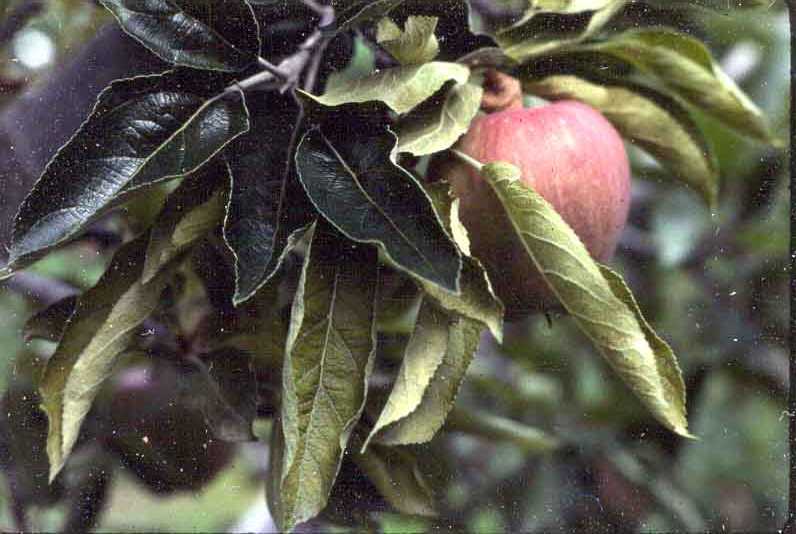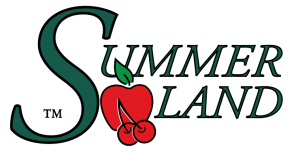European Red Mite
General Description
Hosts
All tree fruits.
Damage
Leaves - Speckled when lightly infested, bronzed when heavily infested (Fig. 1).
 |
| Figure 1. Red delicious leaves damaged by European red mite (H. Philip). |
Fruit - Size and colour may be affected if mites are numerous for a long period.
Identification
Egg - Red or orange, globular and slightly flattened on top, with a white stalk as long as the egg is wide (Fig. 2).
| Figure 2. European red mite eggs (H. Philip) |
Immature - Red, orange or green with 6 (larva) or 8 (nymphs) legs (Fig. 3).
Adult female - Globular, reddish-brown with white spines arising from raised white spots on upper side (Fig. 3).
Adult male - Light red or green with pointed abdomen (Fig. 3).
| Figure 2. Life stages of European red mite (AA-FC). |
Life History
Overwintering eggs occur in clusters on roughened areas of bark on twigs and smaller branches, often on the undersides of fruit spurs and at forks of small branches. Eggs hatch at the pink bud stage, and young mites feed upon the opening flowers and developing leaves. The mites continue to feed upon leaves during the spring and summer, increasing in numbers in response to warm temperatures. There may be as many as 6-7 generations per year. Populations generally decline by mid-August, and females lay overwintering eggs during August and September.
Monitoring
Dormant season (apple only) - Collect 5 fruit spurs per tree on 20 trees selected at random from each hectare of orchard. Count or estimate the number of eggs on the terminal 4-cm of each spur, starting at the base of the bud.
Summer - Monitoring is especially important if you apply Sevin thinning sprays and either Alias, Assail or Admire each season. The combination of Sevin thinning sprays and more than one or more applications of any of Alias, Assail or Admire increases the risk of mite damage in the current or following year. Examine leaves throughout the orchard to assess average numbers of active European red mites and predatory mites. Inspections every week or two are desirable to evaluate population trends and tree response. Numbers of both plant-feeding and predatory mites may be determined either by hand lens examination or through one of the mite counting services. Check with your crop management advisor for addresses of these monitoring services.
Management
Biological Control
Several species of predatory insects and mites attack all stages of plant-feeding mites to keep populations below damaging levels in most tree fruits. Pear trees cannot tolerate high enough numbers of plant-feeding mites to support the predatory mites needed in integrated control. Chemicals applied for controlling other pests and diseases may upset the ratio of plant-feeding to predatory mites, reducing the effect of biological control. Therefore all pesticides and application rates recommended for integrated mite control in apple will conserve predatory mites. Refer to the table – Relative Toxicity of Insecticides/Miticides to Common Beneficial Mites and Insects – as an aid to selecting least disruptive control products.
Cultural Control
Healthy, well-maintained trees will tolerate higher mite populations than weak or stressed trees.
Chemical Control
If predatory mites are present in apple and pear orchards and not exposed to harmful sprays (such as several Sevin thinning sprays), summer sprays of miticides are not usually necessary. No action threshold has been determined for European red mite on soft fruits except where noted below.
Early season- On apple, if an average of over 50 European red mite eggs per spur is present in the dormant sample, apply dormant oil during the 15 mm green-bud to tight-cluster bud stage. This spray is especially important to integrated control because it favours survival of predatory mites and apple rust mite. Oil has a physical effect on mite eggs. A physical control method is not susceptible to resistance development. A well-applied oil spray will keep European red mites at a low level until summer.
If the number of overwintering European red mite eggs is greater than 50 eggs per spur between petal fall and first cover, use either of the following miticides as per label instructions:
-
Apollo SC on apple, nectarine, peach, and pear after bloom when adult mites first appear. Apollo is a specific miticide that acts primarily on mite eggs and has some effect on young mites but does not control adult mites. Apollo does not harm predatory mites, bees or beneficial insects. Do not apply Apollo more than once per season.
-
Agri-Mek 1.9% EC or Agri-Mek SC plus 0.25% oil before there are 5 mites per leaf on apple and before 2 mites per leaf on pear. Do no apply more than once per season on apple or more than twice per season on pear. Apply Agri-Mek with 0.25% oil to improve absorption of the chemical into the leaves and to increase the residual control of mites. Applications later in the season have shorter residual control as older leaves absorb less chemical. Agri-Mek plus oil treatment may cause russeting on thin-skinned apple varieties such as Golden Delicious and on d’Anjou pears. Use Agri-Mek in rotation with products with different modes of action to avoid development of pesticide resistance. Check the product label for additional precautions.
-
Danitol on apple. Maximum one application per year. Restricted entry interval (REI) varies depending on activity.
-
Envidor 240SC on all tree fruits except prunes and plums. Do not apply more than once per season nor within 7 days of harvest. Envidor controls all stages of European red mite and will also control any spider mites and rust mites present.
-
Acramite 50 WS on apple. Do not apply more than once per season nor within 7 days of harvest. Will also control any spider mites present.
-
Kanemite 15 SC on apple and pear. Do not apply more than once per season nor within 14 days of harvest. Will also control any two-spotted spider mites present.
-
Nealta Miticide on apple and pear. Nealta controls all life stages of European red mites and will also control any spider mites present. Do not apply more than two times per season nor within 7 days of harvest.
-
Nexter 75WP on apples and pears; do not apply more than two times per season or within 25 days of harvest. Controls all stages of mite development. Also controls rust mites.
Summer- See the precaution under Monitoring above regarding impact Sevin thinning sprays and use of Alias, Assail and/or Admire on apple. Control of European red mite on apple is only necessary if a leaf examination of trees throughout the orchard, or in a problem area, shows that there is an average of more than 15 active red mites per leaf and more than 10 red mites for each predatory mite. After mid-July, European red mite levels can reach 30-50 or more per leaf, particularly on vigorous trees, before spraying is necessary. At these levels, some leaf mottling or bronzing may occur but will not affect fruit size and colour and next year’s crop.
Recommended summer sprays are:
-
Acramite on apple
-
Envidor on all tree fruits except prunes and plums
-
Nexter on apple, pear, sweet and sour cherries
-
Agri-Mek plus 0.25% oil on apple and pear
-
Kanemite on apple and pear
-
Nealta on apple and pear
-
Purespray Green Spray Oil 13E (suppression only)
Envidor, Nexter, Nealta, Purespray Green Spray Oil 13E and Agri-Mek are satisfactory for integrated control as they do not eliminate predatory mites. Do not use Envidor, Nealta or Nexter more than once per season.
Pesticide resistance management - It is important to alternate products from different chemical classes or with different modes of action to avoid the development of resistance. To prevent development of resistance to any class of chemicals, do not use products with the same Group Number (see product label or Spray Schedules) in successive sprays.
